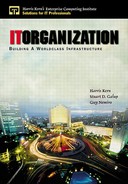What Is the Infrastructure?
We refer to the infrastructure as the network, data center facilities, server rooms, wiring, desktop, RDBMS, OS, integration, applications support, processes, metrics, service level agreements, systems management tools, all computer-related hardware, COTS (commercial off the shelf) software such as financial applications, e-mail systems office tools, and people. The most important ingredient and most difficult challenge is the staffing, the people, the human element. It's really everything to do with the computing environment.
There's one area of the infrastructure with which we purposely are only dealing in a partial way: applications or systems development.
This area is flourishing more than ever before. After all, this is the area everyone has been focusing on throughout the 1990s. In the 1960s, 1970s, and early 1980s, applications development took a back seat to the infrastructure. Now the roles are reversed. In our opinion—based on the studies we performed— applications development is not the problem except that the process of developing applications must take into account how the applications or systems will be supported in the production environment. We've seen too many instances where the development staff has created applications in a vacuum without regard to how they will be used in the production world. When this happens, the applications development team can't meet with success because the applications can't successfully go live.
The issues the applications developers have (i.e., development tools, processes, QA, etc.) are not as severe as the production support side of the infrastructure. For the purposes of this book we'll exclude applications development when we refer to the infrastructure and that's only because the problems are not as serious in this area. The issues the applications developers have are not as severe as the production support side of the infrastructure.
This all started in the late eighties when client/server gained enormous popularity. IT's customers just wanted to build new systems as quickly as possible. They could not have cared less about the infrastructure. Maybe that's a bit harsh. It's not that they didn't care, it's that there was never the time or budget to address it properly. Herein lies the problem. This has been going on for over a decade now. Starting in the sixties, it took over two decades to get the mainframe infrastructure to where it is today: a highly reliable, available, and serviceable (RAS), yet bureaucratic computing environment. In the past 10+ years we've been incorporating new technologies (e.g., Unix and NT) in this environment at a torrid pace without investing in resolving people and process issues to compensate for this influx of technology. You cannot keep pushing and pushing without focusing on the people and process issues. The infrastructure is bleeding profusely, and IT management had better start paying attention.
